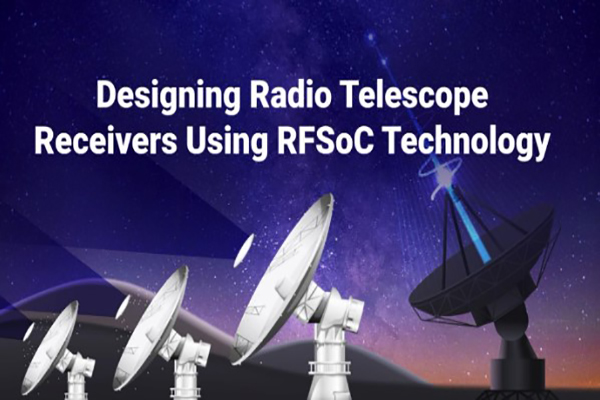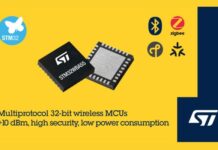There is a new era of multi-frequency astronomy, in which equipment for observing different types of radio waves is used together to reveal more than they could do individually. In much the same way that you tune the radio to a particular station, radio astronomers can tune their telescopes to pick up radio waves millions of light years from Earth. Using sophisticated computer programming, they can unravel signals to study the birth and death of stars, the formation of galaxies, and the various kinds of matter in the Universe.
A radio telescope is a specialized astronomical instrument designed to detect and study radio-frequency radiation between wavelengths of about 10 meters (30 megahertz [MHz]) and 1 mm (300 gigahertz [GHz]) emitted by extraterrestrial sources, such as pulsars, stars, galaxies, and quasars. Detecting faint radio emissions relies on the antenna’s size and efficiency, along with the receiver’s sensitivity for signal amplification and detection. A digital backend receiver is a vital component in a radio telescope system, responsible for digitization, signal processing, and high-speed data transmission.
Radio telescopes typically have three basic components,
- One or more antennas pointed to the sky to collect the radio waves
- A receiver and an amplifier to boost the very weak radio signal to a measurable level
- A recorder to keep a record of the signal
RFSoC: A Building Block for Radio Telescopes
The RFSoC unifies RF data converters, programmable logic, and microcontrollers, providing essential functions for radio astronomy backends like real-time signal processing, digitization, high-speed interfacing, and software control. This highly integrated and power-efficient RFSoC streamlines astronomical backend system design, simplifying the architecture and reducing hardware development costs. The Zynq UltraScale+ RFSoC offers high-performance analog-to-digital conversion, real-time signal processing capabilities, and extensive bandwidth coverage, making it an ideal solution for designing radio telescope backend receivers.
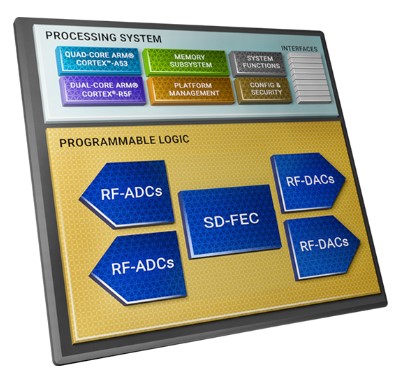
- High-Speed Analog-to-Digital Conversion (ADC)
The RFSoC integrates high-speed ADCs capable of digitizing radio signals with high precision and speed. Pulsar signals are often faint and require sensitive receivers with fast sampling rates. - Real-Time Signal Processing
The integration of FPGA and ARM processors within the RFSoC enables real-time processing of radio signals. This feature is invaluable in radio astronomy, allowing for the rapid analysis of celestial data and the detection of transient events, such as fast radio bursts and pulsar emissions. - Versatility and Adaptability
FPGAs are known for their reconfigurability. Radio astronomy often involves implementing various algorithms to detect weak signals, perform pulsar searching, and conduct interference mitigation. - Energy Efficiency
Radio telescopes are often located in remote or off-grid areas to minimize interference from human-generated radio signals. The energy-efficient design of the RFSoC is crucial for maintaining these observatories and ensuring their uninterrupted operation. - High-Speed Data Transfer
The inclusion of high-speed serial transceivers facilitates the efficient transfer of large datasets from radio telescopes to data processing facilities. This is essential for interferometry applications and the creation of high-resolution images using data from multiple telescopes.
RFSoC-based Backend Design
To ensure high-fidelity observational data and meet diverse scientific objectives, a multi-function digital backend can be designed with cutting-edge technologies like ZU49DR Zynq UltraScale+ RFSoC development boards. This advanced system directly samples RF signals at the receiver’s front end and offers flexible processing modes. This approach effectively mitigates signal gain and phase fluctuations caused by environmental factors during transmission.
The figure below provides an overview of the radio telescope backend system, which is built on a heterogeneous architecture incorporating RFSoC, CPU, and GPU components. It includes a Signal acquisition and pre-processing block, a multi-function post-processing block, and a recorder/storage.
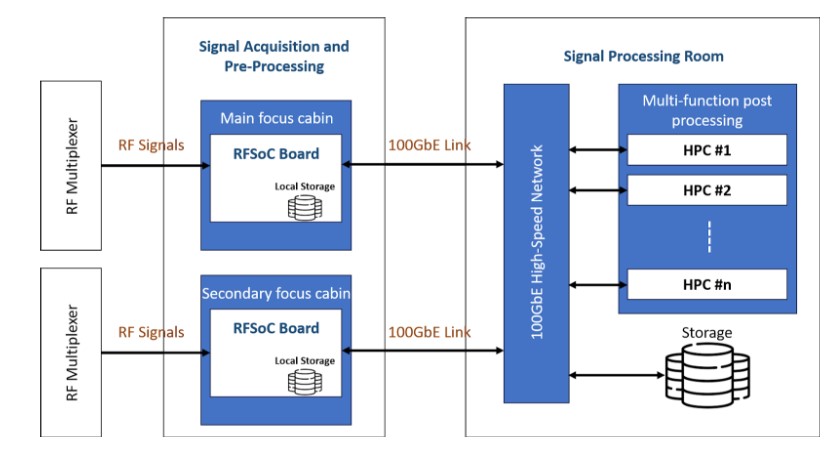
The signal acquisition and preprocessing unit utilize high-performance, low-power RFSoC technology with integrated high-speed 2.5 GSPS ADCs at 12-bit precision. RF multiplexers switch signals from various receivers, covering the entire passband with a maximum simultaneous bandwidth of 14 GHz. It also possesses local storage capabilities for retaining received signals, which can be transmitted to a post-processing unit when necessary for further processing.
The multifunctional post-processing unit accepts high-speed digital signals via a 100 GbE data exchange network. It enables the selection and loading of signal processing modes, including pulsar, spectral line, continuum, and baseband modes. The system offers Radio Frequency interference (RFI) mitigation options tailored to the observed electromagnetic environment. This unit comprises multiple high-performance computer (HPC) nodes that dynamically adjust CPU and GPU computing cores to match signal processing bandwidth and complexity, ensuring flexibility and scalability. Processed high-speed data is buffered into the storage, capable of handling data at a maximum rate of 4 GB/s.
The RF data converters are laid out in tiles, each containing up to four RF-DACs or RF-ADCs. There are multiple tiles available in RFSoC, such that each tile also includes a block, clock handling logic, and distribution routing. This hierarchy of tiles and blocks simplifies the data converter design and implementation.
Designing Radio Telescope Digital Backends using iW-RainboW-G42M System on Module: Powered by AMD Zynq UltraScale+ RFSoC
iWave has designed a powerful System on Module, powered by the ZU49DR RFSoC, that can speed up the design of radio telescopes and utilize the feature-rich RFSoC. The RFSoC SoM features the industry’s highest RF channel count with 16 Channel RF-DACs @ 10GSPS and 16 Channel RF-ADCs @ 2.5GSPS.
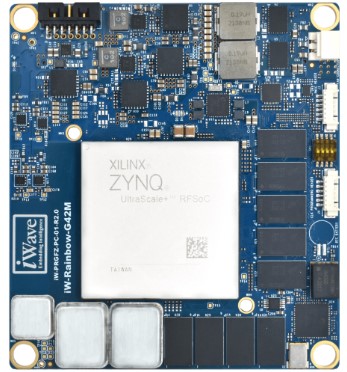
iW-RainboW-G42M System on Module features the ZU49DR and is compatible with the ZU39 and ZU29. The SoM offers a multi-element processing system, including an FPGA, Arm Cortex-A53 processor, and a real-time dual-core Arm Cortex-R5, and high-speed ADC & DAC channels, which makes it able to acquire, process, and act on RF signals. The RFSoC SoM offers onboard 8GB 64bit DDR4 RAM with an error correction code for the processing system and 8GB 64bit DDR4 RAM for programmable logic.
The integrated ultra-low noise programmable RF PLL simplifies the utilization of the SoM in the end product, eliminating concerns about complex clocking architecture. This integration also empowers the system with the highest signal processing bandwidth throughout the comprehensive RF signal chain. Furthermore, it boasts support for SyncE and PTP network synchronization, ensuring a high degree of synchronization.
The module leverages the AMD Zynq UltraScale+ RFSoC Gen3 device, making it ideal to be deployed into RF systems that demand small footprint, low power, and real-time processing. Furthermore, the SoM brings in a drop-in solution for customers who want to simplify the design architecture, expedite the implementation process of astronomical digital backends for radio telescopes, and reduce device power consumption and hardware development costs.
iWave has also engineered an innovative RFSoC PCIe ADC DAC data acquisition card, driven by the G42M Zynq UltraScale+ RFSoC SoM. The 3/4 Length PCIe Gen3 x8 Host Interface on the board connects the RFSoC PCIe Card to the computer/server.
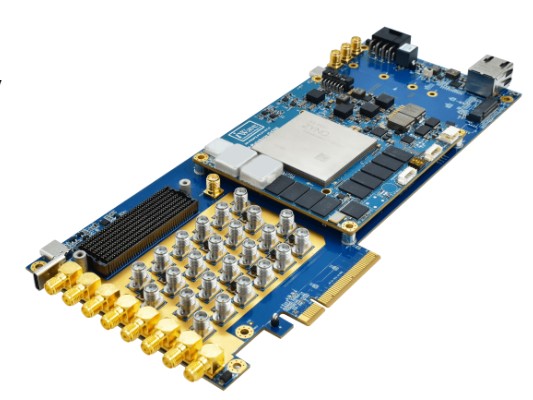
This card incorporates state-of-the-art RF and signal integrity design techniques to ensure high-speed connectivity. Its adaptability enables users to seamlessly integrate this technology into their specific applications, offering a versatile solution for field deployment.
Complementing the RFSoC’s on-chip resources, the iWave RFSoC ADC DAC PCIe Card adds,
- 16 ADC Channels
- 4 x Right Angle SMA connectors on the Front Panel with Balun (BW-800MHz-1GHz)
- 4 x Straight SMA connectors with Balun (BW-800MHz-1GHz)
- 4 x Straight SMA connectors with Balun (BW-700MHz-1.6GHz)
- 4 x Straight SMA connectors with Balun (BW-10MHz-3GHz)
- 16 DAC Channels
- 4 x Right Angle SMA connectors on the Front Panel with Balun (BW-800MHz-1GHz)
- 4 x Straight SMA connectors with Balun (BW-800MHz-1GHz)
- 4 x Straight SMA connectors with Balun (BW-700MHz-1.6GHz)
- 4 x Straight SMA connectors with Balun (BW-10MHz-3GHz)
- NVMe PCIe Gen2 x2/x4 M.2 Connector
- FMC+ HSPC Connector
The System on Module and the PCIe Card are go-to-market and production-ready complete with documentation, software drivers, and a board support package. iWave maintains a product longevity program that ensures that modules are available for long periods of time (10+ years).


